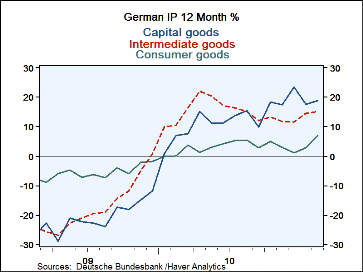 Global| Apr 07 2011
Global| Apr 07 2011German IP Continues Its Strong Rise
Summary
Industrial output is advancing smartly in Germany across all three main sectors. The output of consumer goods is finally in gear, rising at a 2.3% annual rate. Intermediate goods output is up at a 16% annual rate. Capital goods the [...]
 Industrial output is advancing smartly in Germany across all three main sectors. The output of consumer goods is finally in
gear, rising at a 2.3% annual rate. Intermediate goods output is up at a 16% annual rate. Capital goods the sector that has led
the German rebound is now in a following role with output up at a withering pace, but quite strong at 7.9% over three months.
Industrial output is advancing smartly in Germany across all three main sectors. The output of consumer goods is finally in
gear, rising at a 2.3% annual rate. Intermediate goods output is up at a 16% annual rate. Capital goods the sector that has led
the German rebound is now in a following role with output up at a withering pace, but quite strong at 7.9% over three months.
Both MFG IP and Orders continue to expand strongly. The ongoing rise in orders paves the way for output to continue to expand.
In the unfolding quarter Output is up at a 10.9% pace; MFG output is up at a 7.5% pace. Construction is rising at a super strong 77.9% annual rate. And, of course orders continue to push the envelope farther rising at an 18.4% pace.
If we compare the German trends for those of all of EMU, we make comparisons through January. Through January Euro-Area IP is up by 9.5% over 12-months while German output is up at a 14.5% pace. While German contributes strongly the Euro-Area rise output in France is up at a 7% pace and in Italy at a 5.6% pace. Even in Spain IP is expanding but just by 0.1% Yr/Yr. While Germany leads the Zone and boosts its performance the rest of the Zone is still growing solidly if not as strongly as Germany at least in manufacturing.
Against that background the ECB has begun to hike rates. The rate hike was first expected to be part of series of hikes but Trichet is now trying to distance the Bank from that view. In time we will see what markets come to believe. At a time that special circumstances are pushing up commodity prices, boosting headline inflation, with core inflation still rather well tempered and with financial crisis still spreading in Europe, it is strange time to be putting up rates in Europe. While the MFG sectors are generally strong only in Germany is the services sector relatively buoyant and consumer confidence too. In the rest of the Zone the consumer is struggling and so are the various services sectors.
| Total German IP | |||||||
|---|---|---|---|---|---|---|---|
| SAAR Except M/M | Feb-11 | Jan-11 | Dec-10 | 3Mo | 6Mo | 12Mo | Qtr-2-Date |
| IP total | 1.6% | 2.0% | -0.6% | 12.4% | 9.3% | 14.7% | 10.9% |
| Consumer | 1.4% | 2.2% | -0.6% | 12.3% | 4.7% | 6.9% | 10.9% |
| Capital | 1.6% | -5.1% | 5.6% | 7.9% | 12.3% | 18.9% | -4.5% |
| Intermed | 1.0% | 5.9% | -2.9% | 16.1% | 8.1% | 15.2% | 21.5% |
| Memo | |||||||
| Construction | 3.4% | 35.2% | -24.2% | 26.1% | 14.9% | 34.1% | 77.9% |
| MFG IP | 1.4% | 0.3% | 1.1% | 11.5% | 9.0% | 15.3% | 7.5% |
| MFG Orders | 2.4% | 3.1% | 0.0 | 7.2% | 11.4% | 20.4% | 18.4% |
Robert Brusca
AuthorMore in Author Profile »Robert A. Brusca is Chief Economist of Fact and Opinion Economics, a consulting firm he founded in Manhattan. He has been an economist on Wall Street for over 25 years. He has visited central banking and large institutional clients in over 30 countries in his career as an economist. Mr. Brusca was a Divisional Research Chief at the Federal Reserve Bank of NY (Chief of the International Financial markets Division), a Fed Watcher at Irving Trust and Chief Economist at Nikko Securities International. He is widely quoted and appears in various media. Mr. Brusca holds an MA and Ph.D. in economics from Michigan State University and a BA in Economics from the University of Michigan. His research pursues his strong interests in non aligned policy economics as well as international economics. FAO Economics’ research targets investors to assist them in making better investment decisions in stocks, bonds and in a variety of international assets. The company does not manage money and has no conflicts in giving economic advice.






